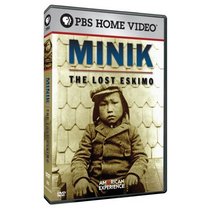| Actor: Joe Morton Director: Axel Engstfeld Genres: Indie & Art House, Television, Educational, Documentary Sub-Genres: Indie & Art House, Television, Educational, Biography, History Studio: Pbs (Direct) Format: DVD - Color,Widescreen DVD Release Date: 05/06/2008 Original Release Date: 01/01/2008 Theatrical Release Date: 01/01/2008 Release Year: 2008 Run Time: 1hr 0min Screens: Color,Widescreen Number of Discs: 1 SwapaDVD Credits: 1 Total Copies: 0 Members Wishing: 3 MPAA Rating: NR (Not Rated) Languages: English |
Search - American Experience: Minik, the Lost Eskimo on DVD
  | American Experience Minik the Lost Eskimo Actor: Joe Morton Director: Axel Engstfeld Genres: Indie & Art House, Television, Educational, Documentary NR 2008 1hr 0min In 1897, Robert Peary returned to New York from his latest Arctic expedition with five Eskimos for study at the American Museum of Natural history. Anthropology regarded the Eskimos as a rare species. Within months, four o... more » |
Larger Image |
Movie DetailsSimilar Movies
|
Member Movie ReviewsReviewed on 9/25/2012... I'm not sure what the intent of this film was. Themes on "the last of his tribe" are American's wet dream, but that may be another subject. My purpose is just to correct a few assumptions in the other review posted here. In general it is a good review, and asks questions about what has been omitted. Here are a few issues raised in the review: The work says that "Minik was horrified to learn that after a sham burial, his father's skeleton was on display at a museum." Native people have a respect for the dead. They go to great lengths to send their relatives on to the next world in a good way. There are various consequences of not following the rituals for the dead. With approx. 500 tribal nations, there are also diverse ritual practices for sending loved ones on to the next world. I would say "horrified" doesn't come close to describing Minik's response. The reviewer continues with, "I really wonder if his situation helped to get the Indian Repatriation Act passed decades later." Well, probably not. Read up on the battle over The Kennewick Man's remains. Few museums have returned Native remains without a fight; and the law might apply as well to private land owners who continue to sell remains and artifacts on the black market. One more point: the reviewer wrote, "I wonder if many of the Native American children forced to attend American private schools felt the same way." Native children were forcibly removed from their homes and taken, not to "private" schools, but schools more akin to reform schools where the objective was re-education: to beat the Indian out of them, to rape and molest Indian children; to cut their family and tribal ties, and to assimilate them into the American way of life, teaching them English and low level work skills (because very little was expected of them). None of this has to do with the film, but since the other reviewer brought up questions not answered by the film, I'm simply correcting the reviewers' assumptions. This film is not high on my list. 2 of 3 member(s) found this review helpful.
Movie ReviewsAn important figure for American history Jeffery Mingo | Homewood, IL USA | 05/07/2008 (4 out of 5 stars) "Robert Peary is a Caucasian who wants to be the first to make it to the North Pole. He brings back six Inuits to NYC and only one, a boy named Minik, survives. Usually the American Experience series covers events or famous people. It's great that the series here covers a person most won't know, but should.
The work says that Minik was horrified to learn that after a sham burial, his father's skeleton was on display at a museum. I really wonder if his situation helped to get the Indian Repatriation Act passed decades later. When he returns to an Inuit tribe and feels neither American nor Inuit, I wonder if many of the Native American children forced to attend American private schools felt the same way. This work never connects Minik's troubles with those of many indigenous people in this nation. Perhaps these parallels are not made because some say Inuits should not be lumped with American Indians of the Lower 48. On many occasions, living Native Americans are interviewed in documentaries were Native themes appear. The American Experiment installment on Buffalo Bill interviewed a living Lakota on how Sitting Bull and other Natives must have felt in Bill's traveling show. In the documentary "Grizzly Man," a Native man speaks about how Natives try to avoid grizzlies, rather than embrace them. This work had no Inuit scholar who, through research and not essentialism, could have connected the dots about Inuits of the time and their contact with Americans. This documentary starts with Peary's contact with Minik, but it illustrates who their paths merged and briefly later came together. This work makes no mention of the African-American Arctic explorer Matthew Henson. This documentary never explains how Peary may have harmed this Black man as he also may have harmed Minik's Inuit relatives and peers. In the documentary that I saw on Henson, I thought it was suggested that Peary did reach the North Pole. However, this work says he flatly did not. This work focused on a diverse individual. It covers fascinating issues at the crossroads of history, anthropology, ethnic studies, and more. I recommend this." |




